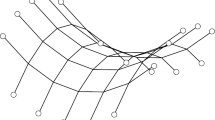Abstract
Maximum and minimum principles for the steady-state finite cable model of nerve membranes are derived from the canonical theory of complementary variational principles. An accurate variational solution is obtained in an illustrative calculation.
Similar content being viewed by others
Literature
Arthurs, A. M. 1970.Complementary Variational Principles. Oxford: Clarendon Press.
Hooke, R. and T. A. Jeeves. 1961. “Direct Search Solution of Numerical and Statistical Problems.”J. Assn. Comput. Mach.,8 212–229.
Jack, J. J. B., D. Noble and R. W. Tsien. 1975.Electric Current Flow in Excitable Cells. Oxford: Clarendon Press.
Kootsey, J. M. 1977. “The Steady-State Finite Cable: Numerical Method for Non-Linear Membrane.”J. Theor. Biol.,64, 413–420.
Walsh, G. R., 1975.Methods of Optimization. London: Wiley.
Author information
Authors and Affiliations
Rights and permissions
About this article
Cite this article
Anderson, N., Arthurs, A.M. Complementary variational principles for the steady-state finite cable model of nerve membranes. Bltn Mathcal Biology 40, 735–742 (1978). https://doi.org/10.1007/BF02460604
Received:
Issue Date:
DOI: https://doi.org/10.1007/BF02460604




